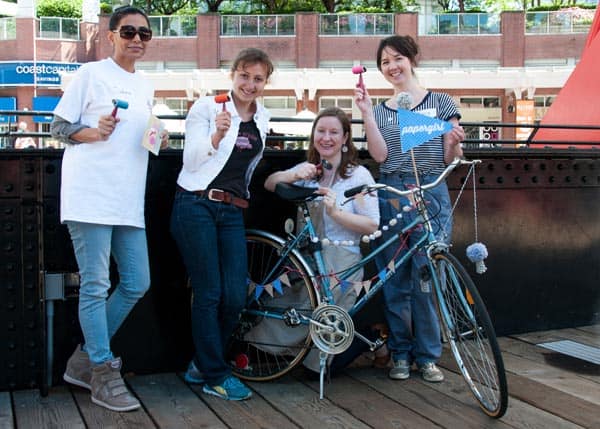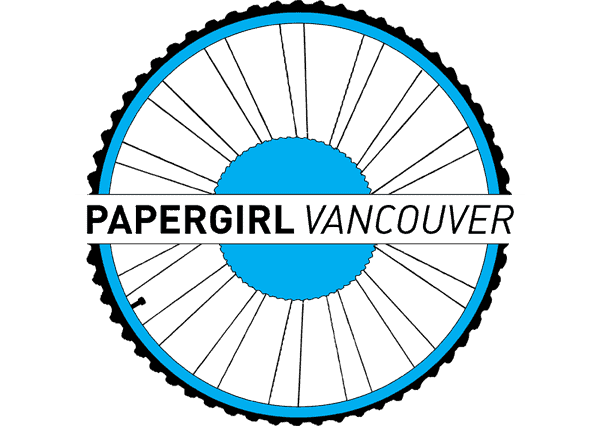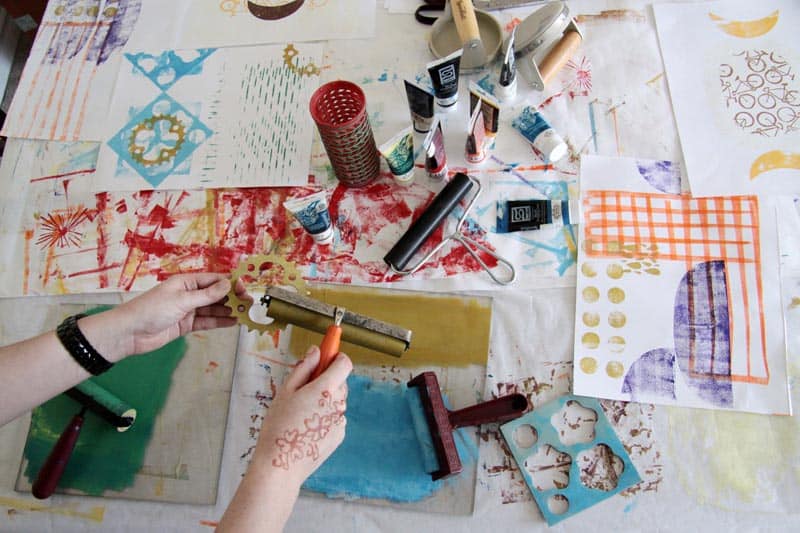You’re walking down the street when suddenly a smiling stranger rides up to you on a bike and hands you a rolled up document. It’s a work of art, she says, and it’s yours. She doesn’t want anything in return, except maybe to see your face light up. Then she bikes away.
She’s a Papergirl, part of the international Papergirl movement that aims to make art more accessible, affordable, and egalitarian, all the while creating social change within the cities where it takes place. Each city holds exhibitions, and then the art featured is handed out to unsuspecting strangers on the street.
The exhibitions take place once a year and are held for one week. Anyone can submit art, and all pieces are accepted (with a maximum of three per artist). The only guidelines are that it must be dry and flexible so that they can roll it up and give it to a stranger. Vancouver’s chapter has received art from all over the world, including places like Japan, Poland, and Germany.
Organizers prefer not to use the word “free” when it comes to giving away the art, which they say belittles the talent and hard work that went into each piece. Instead, they call the art a gift. And indeed, it is.
Vancouver’s 2013 exhibition opens tonight, so we caught up with volunteer Danielle Leroux.
Shedoesthecity: Tell us a bit about the history of Papergirl.
Danielle Leroux: Papergirl began in Berlin in 2006 when it was founded by artist Aisha Ronniger. Ronniger was inspired to begin the project after hearing a media debate that was trying to equate the prosecution of public postering with doing graffiti. Ronniger and her friends wanted to explore other ways to make art in public space, and Papergirl was born. The project aims to redefine street art by combining art, philanthropy, and bicycles. After an open call for art (artists of all kinds are welcome), the art is exhibited for one week. On the final day of exhibition, the art is taken down and rolled up. It is distributed by a team of volunteer cyclists in the style of American paperboys (or should I say papergirls) to completely unsuspecting strangers.
Papergirl has since become a global art movement and has spread to cities throughout the world. Though each city makes the project their own, Papergirl’s core themes include an open call for art, a non-juried and uncurated exhibition, analogue works (versus digital), the gift of giving art, altruism, inclusivity, and non-commerciality.
SDTC: How long has Papergirl been in Vancouver? Is it anywhere else in Canada as of now?
DL: Papergirl arrived in Vancouver in 2011 and is celebrating its third birthday this year. Papergirl projects continue to pop up in cities in Canada and across the world. Some of the project locations in Canada include Papergirl Calgary (started by a former Vancouver Papergirl), Papergirl Toronto, and Papergirl Kelowna.
SDTC: What do you think makes this idea so popular?
DL: I think Papergirl approaches community art and engagement in a really unique way. Unlike traditional public art projects (which people can generally walk by and look at), Papergirl actively tries to engage all members of the community, from spectators, to practicing artists, to hobbyists, to other arts organizations, to local businesses. It challenges the traditional market economy by giftingart, and has a fantastic element of surprise to it: strangers are often a little bit confused when we offer them the art! And little do they know what art is going to be inside. Art recipients are also encouraged to contact the artist of the work they received, further helping to build the sense of community and conversation Papergirl Vancouver strives to create. It’s not every day you see a group of over 30 cyclists riding out on colourfully decorated bicycles and gifting art.
In a city like Vancouver that can sometimes receive a bad reputation for being a bit unfriendly, Papergirl works to overcome this by using art as a vehicle for building community and ultimately creating social change. On the other hand, we’re fortunate to be in a city that has such a fantastic bike culture. Papergirl seems to really thrive in cities that love biking.

SDTC: What can Vancouverites expect from the opening exhibition?
DL: First and foremost, Vancouverites can expect a wide array of art work from photographs, to prints, to yarn-bombed bikes, to poetry by all skill levels. This year we were fortunate to have some fantastic collaborations with local arts organizations and businesses. You can expect to see artwork created at Draw by Night‘s fourth birthday party, paintings by a local Sparks unit, creations by artists whose studios we visited, and much more. We list of all our contributing artists on our website and feature their work on our Flickr page.
SDTC: Why is making art accessible so important?
DL: Art is an incredibly important part of life. It teaches us about the world and about human experience, increases people’s capacity for life, challenges the way society is run, provides social value, and sometimes it is just beautiful (and sometimes it’s just bad). Art can change the world, so why restrict its reach to only a limited number of people found only in a few stuffy inaccessible places?
Art is often narrowly associated with class, and the art market is accused of being inflated and for the elite. There is a whole other side of art, however, that is playful, generous, and human, but is left out of the equation or nullified by the market. Papergirl functions as a kind of performance in opening up dialogue around art as a commodity.
SDTC: Your website talks about the “art of giving art.” What does that mean?
DL: We view this simple act as a significant performance, where the individual artworks become part of a larger community-engaged project. The gifting of art takes Papergirl participants and strangers outside of their everyday experience of the traditional market economy that identifies art consumers by socio-economic class and education. When an artist gives their work as a gift, they build a relationship with the recipient and with others affected by their creativity and this act of kindness. Papergirl brings art back to its identity as true creativity: a “pure gift” that builds community through sharing.
SDTC: What are the goals of Papergirl?
DL: In 2012, the Vancouver Foundation came out with some solid research on the number one problem faced by Vancouverites: one quarter of our population suffers from isolation and loneliness, and the majority of people complain on some level about the difficulty of meeting new people and a lack of community. Papergirl Vancouver is taking steps to combat this problem by using art as a vehicle for social change.
Papergirl Vancouver’s 2013 exhibition opens TONIGHT (Tuesday, August 13) from 6:00pm to 8:30pm at the Roundhouse Community Centre (181 Roundhouse Mews). Want to submit your art for next year? Find out more information here! And keep an eye out for friendly people on colourful bikes—they just might have something to give you.




 Follow Us On Instagram
Follow Us On Instagram
